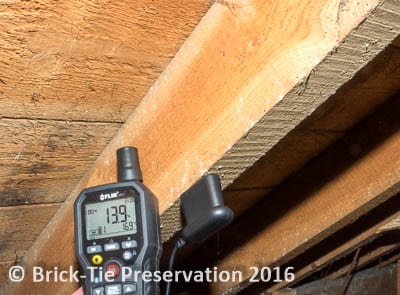Here’s some basic information on how damp specialists use electronic moisture meters as an aid to damp diagnosis.
Why use an Electronic moisture meter?
Well that’s a good question, because in many respects these electrical moisture meters are held responsible by many commentators for much of the unnecessary damp proofing work which has been done all over Yorkshire over the past few decades.
In many cases a meter is not essential to diagnose a damp problem; leaking gutters, eroded pointing and condensation are a few examples of where a meter may not be required.
Visual evidence is still by far the best thing a surveyor has for diagnosing damp. However, not all damp results in a nice visible pattern or an obvious pointer and this is where a meter is useful.
The most commonly used electronic moisture meter is a resistance or conductivity meter. These pass an electrical charge through the materials being tested, which flows better; with less resistance when the materials are damp. I use a General electric MMS model, which has this function and a few others built in, which cover humidity, temperature and such. The most common mode I use on a daily basis, is the conductivity mode – in effect I stick pins in the material I’m testing and check how high a reading I get.
Now then, you’d think that the higher the reading the ‘damper’ the material is? Not always; in masonry the meter offers only a guide to how much moisture there is, relative to other parts of the wall/plaster. This is because materials vary in porosity and their natural moisture content. This means that the meter is taking a qualitative reading not a quantitative reading.
Why bother with an electronic moisture meter, if the reading cannot be trusted?
Well, it depends on the situation. The actual moisture content of say, a length of wall is not that important when diagnosing a straightforward damp problem. What is important, is the distribution of the moisture through that material; a conductivity meter is very good at providing that information. This means that rather than looking at the readings as absolute quantities we, as damp specialists are more interested in how damp or dry the various parts of a wall are, relative to each other. This helps us decide where the moisture came from and how to stop it.
We call this process – moisture profiling.
Moisture profiling is a very useful tool and it’s why electronic moisture meters are essential in any damp surveyor’s kit. However, as I started off above, the surveyors eyes are still what matter; his experience; knowledge and training, taken together with his readings and any profile he has obtained, are used to form a diagnosis of what the damp problem is.
Good damp diagnosis is the start of finding a solution to damp and without it, any treatment or remedial work will have a very small chance of success. Electronic moisture meters and chemical moisture meters are just tools and like any tool, they need to be used properly. This takes training of the sort offered by The Property Care Association. Surveyors who have the national qualification in remedial treatment are trained in the use of them and display the letters CSRT after their name – always look for this and for PCA membership, when choosing a damp specialist.
You can read more about electronic moisture meters for damp diagnosis on our Technical Director’s blog, including their use in timber surveys and more advanced modes. If you really need to know the true moisture content of a plaster or masonry sample, that is quite straightforward too. Just ask for a chemical (speedy) moisture meter to be used, or gravimetric testing.
All these methods are available as part of our damp survey service throughout Yorkshire.
If you’d like more information on using electrical moisture meters properly why not read Bryan’s detailed blog post on the various types of moisture meter and their pros and cons:

